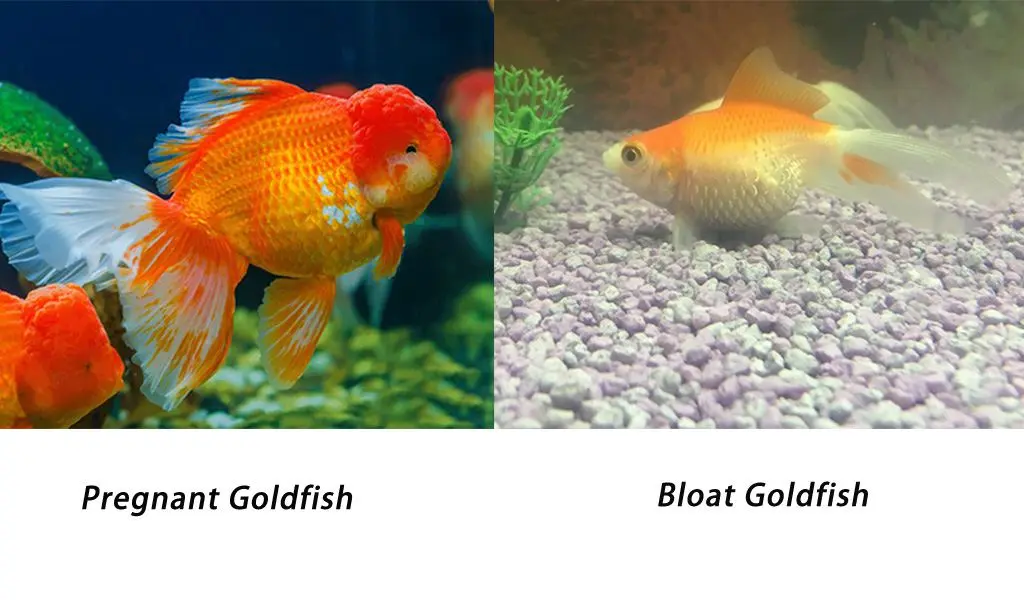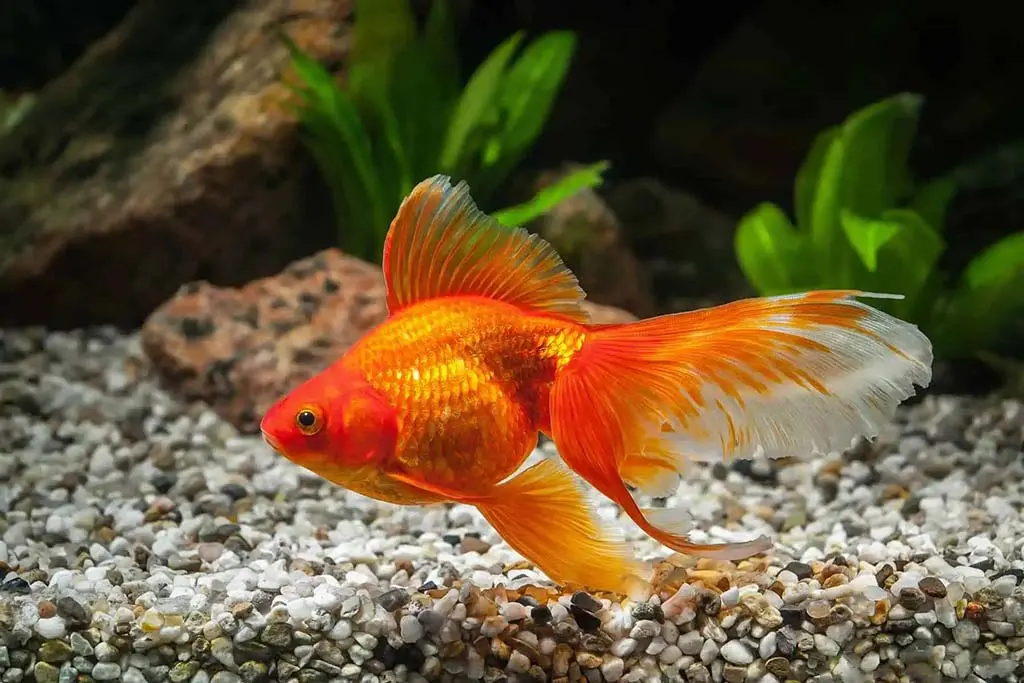A pregnant goldfish, often called “gravid,” has a noticeably swollen belly. The swelling is due to developing eggs inside her.
Goldfish are popular pets known for their vibrant colors and easy maintenance. Identifying a gravid goldfish can be essential for breeders and hobbyists. Swollen abdomens indicate they carry eggs, signaling readiness to spawn. Ensuring a healthy environment supports their breeding process.
Clean water, proper diet, and minimal stress are crucial. Observing behavioral changes helps in recognizing gravid goldfish. They may become lethargic or seek hiding spots. Providing a separate breeding tank can protect the eggs from other fish. Understanding these signs aids in successful goldfish breeding, enhancing the overall aquarium experience.
The Myth Of Pregnancy In Goldfish
Many people believe in the myth that goldfish can get pregnant. This is not true. Goldfish do not get pregnant like mammals. Instead, they lay eggs.
Goldfish Reproduction Basics
Goldfish reproduce by laying eggs. The female goldfish releases eggs into the water. The male goldfish then fertilizes these eggs.
During breeding season, you may notice changes in your goldfish. Female goldfish become rounder. This is because they are carrying eggs.
Male goldfish develop white spots called breeding tubercles. These spots appear on their gills and pectoral fins.
Common Misconceptions
Many people mistake a round female goldfish for being pregnant. But goldfish do not carry live young. They lay eggs instead.
Another common misconception is that male goldfish can get pregnant. Only female goldfish lay eggs. Males only fertilize the eggs.
Sometimes, goldfish may appear bloated due to overfeeding or illness. This is different from carrying eggs. Always check for other signs of health problems.
| Myth | Fact |
|---|---|
| Goldfish can get pregnant | Goldfish lay eggs |
| Male goldfish can carry eggs | Only females carry eggs |
| Bloating means pregnancy | Bloating can be due to illness |

Credit: www.hygger-online.com
Physical Changes In Goldfish
Goldfish undergo several physical changes during pregnancy. Recognizing these changes helps in identifying a pregnant goldfish.
Signs Of Gravidity
Pregnant goldfish display noticeable physical signs. Here are some key indicators:
- Swollen Abdomen: The belly appears rounder and larger.
- Visible Eggs: You may see small, white eggs inside the belly.
- Changes in Color: Pregnant goldfish may have darker scales.
Behavioral Changes
Behavioral changes are also common in pregnant goldfish. Observing these can further confirm pregnancy:
- Slower Movement: Pregnant goldfish swim more slowly.
- Isolation: They often stay away from other fish.
- Resting More: Increased resting is a sign of pregnancy.
Understanding these changes ensures proper care for pregnant goldfish.
Gravid Spot: A Key Indicator
Observing a pregnant goldfish can be fascinating. The most telling sign is the gravid spot. This spot helps identify if your goldfish is carrying eggs. Understanding its location and appearance is crucial.
Location And Appearance
The gravid spot is near the rear of the goldfish. It is close to the anal fin. The spot appears dark and round. It stands out against the fish’s body color. The spot becomes more visible as the fish gets closer to laying eggs. The size and color may vary, but it is usually darker than the surrounding area.
Distinguishing From Illness
It’s important to differentiate the gravid spot from signs of illness. An ill goldfish might show spots or discoloration. These signs often come with other symptoms like lethargy. A gravid spot is specific to pregnancy and usually does not come with other symptoms. If your goldfish shows other signs of distress, consult a vet.
Breeding Behavior Of Goldfish
Goldfish are fascinating creatures, especially during their breeding season. Understanding their breeding behavior can help you identify a pregnant goldfish. Goldfish breeding involves specific rituals and physical traits that are unique to males and females.
Mating Rituals
Goldfish engage in distinctive mating rituals during the breeding season. Males typically start by chasing the females. This chase can last for hours or even days.
Male goldfish will nudge and bump the females to stimulate egg release. The female goldfish will release eggs into the water. The male will then fertilize these eggs. This process is essential for goldfish reproduction.
Male Vs Female Physical Traits
Identifying the physical traits of male and female goldfish is crucial. Males and females have unique features that become more evident during breeding.
| Trait | Male Goldfish | Female Goldfish |
|---|---|---|
| Body Shape | Longer and slimmer | Rounder and fuller |
| Tubercles | White spots on gill covers | Absent |
| Vent | Concave | Convex |
Male goldfish often develop white tubercles on their gill covers and pectoral fins. These tubercles are small white bumps that are absent in females.
Female goldfish usually have a rounder and fuller body. This roundness is more noticeable when they carry eggs. Their vent, or the area near their anal fin, is more convex compared to males.
By observing these traits, you can distinguish between male and female goldfish. This knowledge is helpful in identifying a pregnant goldfish.
Egg-laying Process
The egg-laying process in goldfish is fascinating. Understanding this process helps in providing the best care.
Spawning Environment
Goldfish need a specific environment to spawn. The water should be clean and slightly warm. A temperature between 68°F and 74°F is ideal.
Plants or spawning mops are necessary for egg-laying. These provide a safe place for the eggs. The female goldfish lays eggs on these surfaces.
Egg Development And Release
The eggs develop inside the female goldfish. They grow until they are ready to be released.
During spawning, the female goldfish releases the eggs. The male goldfish fertilizes them immediately.
Each female can lay hundreds of eggs. The eggs are sticky and attach to surfaces in the tank.
| Stage | Description |
|---|---|
| Egg Development | Eggs grow inside the female goldfish. |
| Egg Release | Female releases eggs during spawning. |
| Fertilization | Male fertilizes the eggs immediately. |
| Attachment | Eggs stick to surfaces in the tank. |
Understanding the egg-laying process helps in creating the best spawning environment. This ensures healthy goldfish and successful breeding.

Credit: www.reddit.com
Caring For Pregnant Goldfish
Caring for a pregnant goldfish is important. She needs special attention to stay healthy. This guide will help you provide the best care.
Optimal Tank Conditions
The tank environment is crucial for a pregnant goldfish. Keep the water clean and free of toxins. Use a good filter to maintain water quality.
The temperature should be stable. Aim for a range of 68-74°F (20-23°C). Use a heater to maintain this temperature.
Provide plenty of space. A pregnant goldfish needs room to swim. A 20-gallon tank is ideal.
Dietary Requirements
A balanced diet is essential for a pregnant goldfish. Feed her high-quality fish food. Look for pellets or flakes with essential nutrients.
Include fresh vegetables in her diet. Peas and spinach are good choices. Blanch them before feeding.
Provide protein-rich foods occasionally. Bloodworms and brine shrimp are excellent options. These help with egg development.
Feed small amounts several times a day. This ensures she gets the nutrients she needs.
Aftercare Following Spawning
After your goldfish spawn, they need special care. This ensures both the fry and adult fish stay healthy. Proper aftercare involves several important steps.
Post-spawning Tank Maintenance
Maintaining the tank after spawning is crucial. Start by removing any unfertilized eggs. These eggs can rot and pollute the water. Use a fine mesh net or siphon to gently remove them.
Next, clean the tank. Perform a partial water change, replacing 20-30% of the water. Use a water conditioner to remove chlorine and other harmful chemicals.
Keep the tank clean to prevent disease. A clean tank helps the fry grow strong. Remove any uneaten food daily. This reduces the risk of bacterial infections.
Health Monitoring
Monitor the health of both the fry and adult goldfish. Look for signs of stress or disease. Common signs include clamped fins, erratic swimming, and loss of appetite.
Feed the fry with high-quality food. Crushed flakes, baby brine shrimp, and commercial fry food are good options. Feed them small amounts several times a day.
Ensure adult goldfish get balanced nutrition. Continue their regular feeding schedule. Avoid overfeeding, which can lead to water quality issues.
| Signs of Stress | Actions to Take |
|---|---|
| Clamped fins | Check water quality, perform a water change |
| Erratic swimming | Observe for signs of disease, isolate if needed |
| Loss of appetite | Try different foods, ensure water parameters are stable |
Keep a close eye on water parameters. Use a test kit to check ammonia, nitrite, and nitrate levels. Maintain optimal water conditions to ensure healthy growth.
Regularly check the temperature. Goldfish thrive in water temperatures between 65-75°F (18-24°C). Use a reliable aquarium heater if necessary.
Provide plenty of hiding spots for the fry. Use plants, rocks, and decorations. This helps them feel safe and reduces stress.
Following these steps ensures a healthy environment. Your goldfish and their fry will thrive with proper aftercare.

Credit: www.hygger-online.com
Myths Vs. Facts
Goldfish are fascinating creatures. Many myths surround pregnant goldfish. Let’s separate myths from facts. Understanding what a pregnant goldfish looks like is key.
Debunking Common Myths
Many believe goldfish get a big belly when pregnant. This is a myth. Goldfish do not get pregnant. They lay eggs instead.
Another myth is goldfish give birth to live babies. This is false. Goldfish lay eggs, which then hatch into fry.
Some say a goldfish changes color when pregnant. This is also a myth. Goldfish color change is due to diet or health.
Understanding Goldfish Biology
Goldfish are egg-layers. Female goldfish release eggs. Male goldfish fertilize the eggs.
A female goldfish looks rounder. This is because she carries eggs, not babies.
Goldfish eggs are tiny and sticky. They attach to plants or tank surfaces.
Look for small white spots on male goldfish. These are breeding tubercles, showing he is ready to spawn.
| Myth | Fact |
|---|---|
| Goldfish get pregnant | Goldfish lay eggs |
| Goldfish give birth to live babies | Goldfish eggs hatch into fry |
| Goldfish change color when pregnant | Color change is due to diet or health |
Understanding these facts can help. This ensures proper care for your goldfish. Proper knowledge keeps your goldfish healthy and happy.
Conclusion
A pregnant goldfish, or “gravid” goldfish, has a rounder, swollen belly. This indicates she is carrying eggs. Observing changes in behavior and appearance helps identify pregnancy. By understanding these signs, you can provide better care for your fish. Keep your aquarium environment healthy for a successful breeding process.
